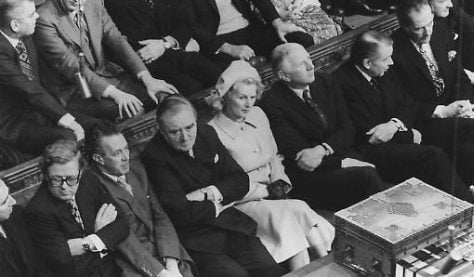(Originally published in the New Statesman blog; Photo source: the New Statesman)
By Ann Pettifor and Douglas Coe
Margaret Thatcher’s economic legacy was prompted by the 1976 Labour government’s capitulation to the IMF – but she took it much further.
It is ironic that Margaret Thatcher’s funeral is to take place at St. Paul’s in the City of London. The world around Wren’s great monument is beginning to unravel as a result of the liberalisation forces she helped unleash. Banks are bankrupt, thousands of jobs lost, and the City’s hard-won reputation for honour and fair play is now in tatters.
The most fundamental economic action of the Thatcher era was to intensify the liberalisation of the financial sector. This was dictated by the City and endorsed by early monetarist economists.
The 1970s inflation was caused originally by this liberalisation and expansion of credit, at domestic and international level: too much money chasing too few goods and services. The Lawson boom of the late 1980s in the wake of attempted government retrenchment came as the money supply again became unhinged. Since the start of the liberalisation of finance at the end of the 1960s, the world economy has been on a roller-coaster, driven by repeated cycles of financial excess, inflations, economic failure and retrenchment. The almost unanimously celebrated 1992-2007 boom was an illusion made possible only by a debt inflation of a more severe kind than that of the 1930s.
As the debate over her legacy rages, economists are loud and united in the claim that Thatcher “fixed” the economy. Economists like Professor van Reenan of the LSE make vague assertions about improvements to the supply side, or to competitiveness. These hark back to arguments deployed by the original monetarists – Samuel Brittan of the FT; Brian Griffiths now of Goldman Sachs and an adviser to the Archbishop of Canterbury; and Peter Jay, ex-economics editor of the BBC. They were arguments used to justify liberalisation, and these policies caused the economy to deteriorate in every conceivable way.
An examination of the post-war economic experiences of Britain was included in a 2010 PRIME report, “The Economic Consequences of Mr Osborne“. 1976 is a key date: the point at which the Labour Government allegedly yielded “Keynesianism” to the IMF’s “reforms” that preceded and anticipated Thatcher’s policies.
The most obvious economic headlines pre- and post-1976 are:
- Unemployment averaged 2.3 per cent a year before reform and after 1976 rose to average 7.7 per cent a year;
- GDP growth was 2.7 per cent a year before reform and 2.2 per cent a year afterwards; and
- Income distribution narrowed almost every year before reform.
And then the real transformation occurred. “The scale of the rise in inequality over the ’80s was unparalleled both historically and compared with most other developed countries” according to the IFS in a 2011 report.
It is also a myth that the Golden Age that preceded liberalisation was burdened by an overreliance on the state, or the public sector.
Before Thatcher came to power, the UK had a thriving manufacturing sector. In 1970, 33 per cent of the economy was accounted for by manufacturing. Today that proportion is 10 per cent. Before Thatcher, the owners of firms felt confident to invest: in real terms, capital investment grew by 4.6 per cent a year before her reforms and only 2.6 per cent afterwards.
Economic activity extended beyond the state and traditional manufacturing; there was a golden age of theatre, of design and of course of popular music. Britain could afford healthcare and education for all; secondary and higher education was free; a safety net protected the few that had no work, and a working pension system looked after the old.
Contrary to the economic profession’s consensus, since reform, the size of government has grown as a share of the economy:
- The broadest measure of the size of government, general government expenditure as a share of GDP, grew from 37 per cent to 41 per cent, post Thatcher.
- In terms of the public finances, public debt measured as a share of GDP fell by an average of 5 percentage points a year in the period before Thatcherism. It rose by 1.3 percentage points per year in the period afterwards.
This growth is of course not the positive result of more government spending on goods and services or of government investment. Rather, it represents the costs of the failure of reform. As the economy deteriorated, the cost of welfare and interest payments rocketed.
In all this debate economists forget what the economy is for. It is not for the rich, or just about “growth” or “competitiveness”. Rather, it provides an outlet for human creativity, and meets humankind’s deep desire to work. It creates frameworks that nurture and protect the young, the vulnerable and the old; that ease the adversities and enhance the pleasures of life for all those that live within it.
On these terms the reforms promoted by the economics profession and implemented by Thatcher have failed the people of Britain – catastrophically.


